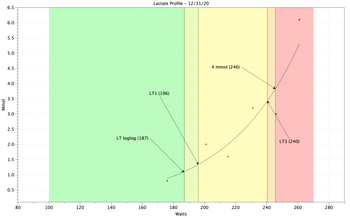How to set HR intensity zones?
-
@michi interesting. Are you determining these with lactate testing?
-
@fazel I think its typical for rowing to be -10-15 bpm.
Also biking to running have this relationship. IE if you do a bike test you can add 10-15bpm for your HR zones of running.
-
@Dimitrios-Kanellopoulos Yes Polar has it.
From a sport scientific standpoint it doesn’t make sense to use standardized HR zones for multiple sports. Depending on the amount of working muscle mass and especially body position (standing, sitting, laying) the AT and LT will be at very different heart rates. Therefore, if you want to train in specific zones (and document it correctly in your training diary), there is no way around setting the intensity zones for every activity specifically. -
@Dimitrios-Kanellopoulos great…now I’m reading this article…
-
@fazel With lactate testing you can determine the aerobic threshold and the lactic threshold perfectly. Of course this is costly / time consuming and gives you only the numbers for the sport you tested. If you are serious about it, it’s worth it and you can calculate AT and LT for other activities with thumb rules.
-
@michi yeah. I actually have one and have done the InScyd test for cycling. It’s expensive to pay for that test though, so I’m trying to come up with some testing protocols to run on my own. If you are going to do this sort of thing, it’s much cheaper to get a meter and become proficient on your own I think. I tried my own step test last weekend. It’s tough because I’m on rollers so I have to stop between tests which is a pain and might skew the data. Here’s a nice site that runs calculations for you.
Here’s the results for my test. I’ve been reading Olbrecht’s book and trying to employ his philosophy to my training.

-
@fazel Nice, I have done my step tests on the bike as well. I was given the training advice from the sport scientist to add 10 beats per minute for running when training in zone 2. Me subjective feeling is, that I have to add even more beats when running.
Inscyd looks interesting. I have listened to a couple of podcasts with (founder?) Sebastian Weber. He is very knowledgeable on this topic.
-
@michi Yes - I’ve listened to the same podcasts probably. He’s good but his ideas don’t seem to be universally accepted (at least not by the TrainingPeaks/WKO guys). They do align almost completely with Olbrecht though. My sense is Olbrecht is the originator and Webber’s work is rooted in his ideas.
Step tests are a pain. The Inscyd tests are interesting. Mine was four efforts, record levels every minute until they decrease. Efforts were sub-maximal except for the last (3 min). Mine were done at home and Steve Neal ran them for me (another excellent dude). I’m nowhere near elite, but he’s real approachable and took time to go over them with me. I paid for two initially and just have to decide when to use the second.
-
@fazel Cool. I can motivate myself for training more easily, when I know the sessions / trainingplan make sense and will make me a better athlete.
-
This feature is so important to me, I have sent my S5 back. Otherwise I really liked the watch. OHM didn’t work for me (but that was expected) and the strap was too short for my wrist, but the S5 is built solidely and GPS worked fine. And of course I dislike the Suunto App.
Have to go for Polar now as I see the Garmin world with my woman’s watch and really don’t like it.
I hope Suunto will introduce the individual HR zones in the next years and create a web based platform again. Then I will be back to Suunto.